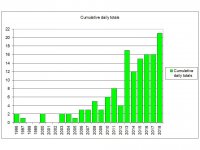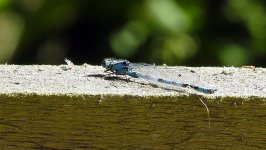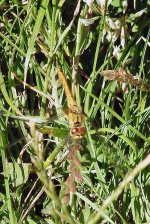upstarts1979
Well-known member
Today at the Reserve
In searing heat the paths at the North Moors and Flashes were cleared of overhanging bramble, nettles and scrub. The grassy area directly in front of the two West hides at Moors was strimmed. Also Julie cleaned out the Flashes hide's. Thanks to all the crew:t:
Birding from 5.45am at the Flashes, where the usual June doldrums is well and truly in place.
The current drought is really biting now and without last year's contract work we would no doubt be looking at the complete drying out of the 2nd flash. Some of the channels are still holding water and others are drying slowly. We expected to be doing some tweaking and in dome ways the drought has highlighted the areas in need.
The Avocet colony have albut given breeding for now and the 3 juvs and their parents have been practising 'high flying'. Its unusual for the male to stay until the chicks are fully fledged but maybe the FOX situation forced it to stay.
Initially there was only 1 teal but more appeared during the morning. Shelduck were down to a single bird and generally duck had decreased in species and numbers. A family party of Whitethroat (4) perched on the stock fence between the cuckoo and avocet hide.
From the Avocet hide I saw 7 grey herons come in from the North and drop down on to the Moors but never saw any when I went there.
FLASHES:-
Teal 10. Gadwall. Shelduck.
Avocet 43. LRP 5. Green Sand 2. Oystercatcher or. Lapwing 31.
Common Tern. BHG 350 including 250 juvs.
Stock dove several juvs now appearing. Green woodpecker. Great spotted w. Kingfisher. Swift 10
Whitethroat family of 4 (3 juvs).
Singing warblers :- Lesser whitethroat. Blackcap. Reed warbler 6. Sedge warbler. Chiffchaff. Cetti's w.
Greenfinch now ever present in the scrub zone between the hen pool and cuckoo hide ..this species is an usual breeder and mostly at the Moors . This is good news as the species is in decline. Goldfinch 15+. Linnet.
Song thrush. Reed Bunting 5+
MOORS:-
GCG . Little grebe 10(1fledged juv).
Wigeon male. Mallard 5 or 6 broods one containing a mix of normal coloured chicks and 6 that are black and diving from a distance they look like tufteds.
Lapwing 4. Oystercatcher adult heard but not seen hopefully it is feeding young in thick vegetation.
Med Gull 2nd summer. Med x BHG hybrid.
Common Tern 2.
Water rail juv North moors.
Swift 20.
Cetti's w juvs East side. Plenty of reed warblers feeding young. Two sedge warblers singing.
Butterfies:-
In the grassland right of the Avocet hide at Flashes - ringlet 15. Meadow brown 12. Marbled white.
In the field behind the Avocet hide is usually cut at this time of year..But at present it has been left for cows to graze. I think it has grown to its normal height and looks a bit brown but just when you think its being left to grow they cut it. Plenty of butterflies in it including 2 Marbled white. Also comma, red admiral. Small tortoiseshell.
Also Ltd of dragons but I'll leave that to Des to sort.
In searing heat the paths at the North Moors and Flashes were cleared of overhanging bramble, nettles and scrub. The grassy area directly in front of the two West hides at Moors was strimmed. Also Julie cleaned out the Flashes hide's. Thanks to all the crew:t:
Birding from 5.45am at the Flashes, where the usual June doldrums is well and truly in place.
The current drought is really biting now and without last year's contract work we would no doubt be looking at the complete drying out of the 2nd flash. Some of the channels are still holding water and others are drying slowly. We expected to be doing some tweaking and in dome ways the drought has highlighted the areas in need.
The Avocet colony have albut given breeding for now and the 3 juvs and their parents have been practising 'high flying'. Its unusual for the male to stay until the chicks are fully fledged but maybe the FOX situation forced it to stay.
Initially there was only 1 teal but more appeared during the morning. Shelduck were down to a single bird and generally duck had decreased in species and numbers. A family party of Whitethroat (4) perched on the stock fence between the cuckoo and avocet hide.
From the Avocet hide I saw 7 grey herons come in from the North and drop down on to the Moors but never saw any when I went there.
FLASHES:-
Teal 10. Gadwall. Shelduck.
Avocet 43. LRP 5. Green Sand 2. Oystercatcher or. Lapwing 31.
Common Tern. BHG 350 including 250 juvs.
Stock dove several juvs now appearing. Green woodpecker. Great spotted w. Kingfisher. Swift 10
Whitethroat family of 4 (3 juvs).
Singing warblers :- Lesser whitethroat. Blackcap. Reed warbler 6. Sedge warbler. Chiffchaff. Cetti's w.
Greenfinch now ever present in the scrub zone between the hen pool and cuckoo hide ..this species is an usual breeder and mostly at the Moors . This is good news as the species is in decline. Goldfinch 15+. Linnet.
Song thrush. Reed Bunting 5+
MOORS:-
GCG . Little grebe 10(1fledged juv).
Wigeon male. Mallard 5 or 6 broods one containing a mix of normal coloured chicks and 6 that are black and diving from a distance they look like tufteds.
Lapwing 4. Oystercatcher adult heard but not seen hopefully it is feeding young in thick vegetation.
Med Gull 2nd summer. Med x BHG hybrid.
Common Tern 2.
Water rail juv North moors.
Swift 20.
Cetti's w juvs East side. Plenty of reed warblers feeding young. Two sedge warblers singing.
Butterfies:-
In the grassland right of the Avocet hide at Flashes - ringlet 15. Meadow brown 12. Marbled white.
In the field behind the Avocet hide is usually cut at this time of year..But at present it has been left for cows to graze. I think it has grown to its normal height and looks a bit brown but just when you think its being left to grow they cut it. Plenty of butterflies in it including 2 Marbled white. Also comma, red admiral. Small tortoiseshell.
Also Ltd of dragons but I'll leave that to Des to sort.
Last edited:








